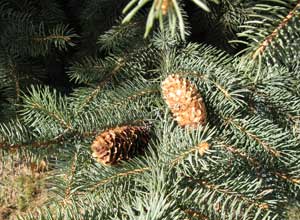Many woodworkers pride themselves on being able to readily identify lumber of various species. They impress the uninitiated by blowing the dust off a stack in the lumberyard and saying, “oh, that’s white oak/red oak/white pine/spruce, etc.” Then they might throw out an offhand tidbit about good uses for the wood.
I’ve learned a few things recently about wood “on the hoof,” as it were – or, perhaps more accurately, “on the root” – that, to me, definitely fall into that interesting tidbit category. 
The first one has to do with identifying certain kinds of lumber while it’s still growing – no need even to see the grain. You do need to be able to see the cones of these conifers, though. This came up when one of my friends mentioned that she had taken a picture of a tree with its “pinecones” pointing up instead of down. She found that unusual. Turns out, it would be very unusual – for a pine. Or a spruce. The cones on both of these conifers grow pointing down. Fir trees, on the other hand, grow cones that defy gravity and point skyward as they grow.
Huh, you may be saying (I know I did), that’s kind of cool.
I’ve learned a few other cool things about trees as I interview a variety of woodworkers for the Today’s Woodworker feature department of our Woodworker’s Journal eZine. One woodworker mentioned that he made one of his walking sticks out of acacia wood, as mentioned in the Bible. At least some woodworkers (who have sent us letters) are under the impression that acacia no longer exists. It does, but it’s not a tree that you’d just amble up to a street corner in Israel and chop down.
According to Stanley Saperstein, “The acacia in the Bible is umbrella acacia because it has an umbrella canopy. It’s a small tree, the size of an apple tree, which in Israel today is highly protected. The wood comes up for sale maybe once in a generation.” Stanley, of course, was in the right place at the right time – with the right client – to build a cane from this rare wood.
Perhaps not quite as rare, but still interesting, is the paulownia tree. The what tree, you ask? I had to have the woodworker who told me about it spell it a couple of times. It’s a tree with Asian heritage that’s now being plantation grown in the southeastern United States to produce a light, strong wood. Among the plantation growers? A former U.S. President who is more known for his agricultural interest in peanuts.
I’ve also learned about cascara buckthorn, a cousin to the rare pink ivory, which grows in the Pacific Northwest. Woodworker Lea Montaire makes turnings from cascara, and had so much to say about it that she wrote an article for the October 2010 issue of Woodworker’s Journal. One thing she mentioned was the natural laxative properties of the bark – everybody in our office thoroughly washed our hands after picking up the wood samples she sent us. In medicine bottles. We appreciated the sense of humor.
There’s a sense within it of a story to tell to interest and impress our friends – a handy use for some of the other information I’ve shared, too. Do you have any tree tidbits to add to the tale?
Joanna Takes
Senior Editor





